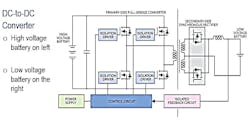Direct Hit: 372575
Vehicle Application: All VW from 1995 through 2006
Tools Used:
- DVOM
- Low amp probe
- Battery tester
- High amp probe
Average Reported Mileage:
94765
Customer Concern:
The battery goes dead after a couple of days. The technician is testing for parasitic battery drain and needs to know what values are acceptable.
Tests/Procedures:
- When testing for parasitic drain, use an ammeter in series with the battery cable and battery. Place a shunt in series with the negative battery cable and connect the meter in parallel to the shunt. (Note: Don’t disconnect battery power from the vehicle. Use a jumper battery to keep the electrical system energized to eliminate problems with antitheft recoding and PCM relearn).
- Start the engine, then turn on and then off every electrical device on the vehicle.
- Turn the key off, close and lock the doors and close all windows and sunroof. Open the shunt to place the meter in series with the negative battery terminal. (Note: Disable any hood alarm switches and close the driver's door latch but keep the door open so the fuse box is accessible.)
- Leave the vehicle undisturbed for of 30 minutes, allowing onboard computers and processors to enter ‘sleep mode.’ After 30 minutes, parasitic load should be 50 milliamps or less.
- Should parasitic load exceed 50 milliamps, pull fuses from the fuse box one at a time until current draw drops below 50 milliamps. Once the high-draw circuit is identified, use wiring diagrams to locate the faulty component.
Tech Tips:
Parasitic loads in the 300 milliamp range usually indicate a computer or processor that has not entered sleep mode. Refer to VW TSB 27-07-11 for a step--by-step alternative method to locate a draw using voltage drop.
Assuming the battery is healthy and the charging system is working properly, this tech decided to look for a key-off current draw to find out what’s killing the battery. A low-current parasitic draw will indeed drain a battery in just a few days, but there’s more than one way to search for it. Also, after repeated discharges, the battery should be tested too.
Current draw through a shunt
The test procedures tell you how to avoid creating new problems. By using a shunt to connect an ammeter (amp meter) to the positive battery circuit, you can preserve the radio security code and the idle speed memory in the Powertrain Control Module (PCM). Even more important, the shunt will also keep the vehicle security system happy, avoiding the need to reprogram or maybe even replacement of the PCM.
The shunt is a jumper wire connected in parallel with the positive battery cable. Getting the shunt connected to both the battery post and battery cable before disconnecting the cable from the battery can be a bit complicated, but it can be done. However, it’s far easier to use a memory saver connector and a booster battery pack that has a 12 V power port. The memory saver plugs into the vehicle’s OBD II connector, supplying both power and ground to every control unit on the CAN bus (Controller Area Network).
If you’re making the shunt yourself, make sure it has an inline 10- or 20-amp fuse, just in case. If you’re using a high-quality Digital Volt/Ohm Meter (DVOM) as the shunt, the fuse inside the meter will typically handle 10 amps continuously or 20 amps for brief periods. If the meter suddenly stops working, check the fuse inside. When the shunt is connected, unplug the memory saver so all the current flows through the meter or shunt.
Low Current Probe
A low current probe is easier to use than a shunt because it clamps around the battery cable. Direct current (DC) flowing through a wire generates a magnetic field around the wire. A Hall-affect sensor in the current probe detects the strength and direction of that field and generates a voltage signal proportional to the current.
When connecting the probe to a DVOM, make sure the probe is connected to the meter’s voltage input, not the current input. If there’s an arrow on the probe, make sure it points in the direction of current flow. Set the probe to its lowest scale and if the meter does not have auto ranging, make sure it’s set to read millivolts (some volt meters have a built-in current probe setting). If there’s more than one wire connected to the positive battery post, make sure the probe is clamped around all of them, or clamp the probe around the negative battery cable. If you don’t get a reading, turn the probe around on the battery cable: remember, current flow is directional. The probe is susceptible to electrical noise, so keep it away from any source of interference.
Voltage Drop
If key-off current is high after 30 minutes, you can pull fuses one at a time until the current draw drops to isolate the high-draw circuit, as outlined in the test procedures. Or you can use a DVOM and a simple voltage drop test.
A volt meter measures the difference in electrical energy between two points in a circuit. Although it’s an imperfect analogy, it helps to think of voltage as pressure. If you probe two points in an active circuit (one that has current flowing through it), the meter should read zero volts because the voltage (pressure) is the same at both points. If there’s any resistance at all between those two points, there will be a measureable voltage across that resistance. In reality, there’s always resistance between two points in an active circuit, even if they’re only half an inch apart, but it might be so small that it can only be detected with a DVOM that can read millivolts.
But here’s the thing to remember: If current is not flowing, there will be no voltage drop, even in the millivolt range. How do we use this to find parasitic battery drain?
Removing fuses to find a high current draw may not be possible because removing/reinstalling the fuse can "wake up" a control unit and ruin the test. Instead, set your DVOM to the millivolt scale and read the voltage drop across each fuse while it’s installed. If the circuit is completely off, no current is flowing and there will be no voltage reading. If current is flowing through the fuse, there will be reading in the millivolt range. Depending on the fuse type and rating, you can use that reading to determine the current. For example, if the voltage drop across a 5-amp standard fuse is 0.3 mV (3 tenths of a millivolt), the current flowing through that fuse is 20 mA (milliamps). The VW service bulletin mentioned in the Identifix Tech Tips includes a 2-page chart showing the current draw for each fuse rating and each measured voltage drop.
In addition to a control unit that’s "still awake," a faulty alternator can also create a parasitic draw, and so can slime, battery acid residue or salt on the battery cable connections. A voltage drop test across each connection in the starting and charging circuits is a good idea in this situation, and just to complete the picture, use a high-current probe to look at starter current draw.



